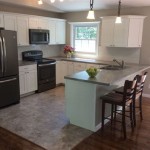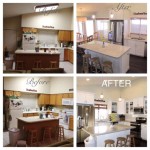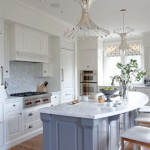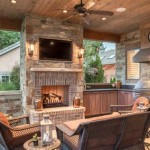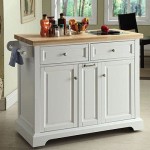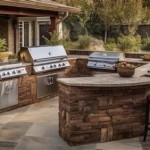The Enduring Appeal and Practicalities of a Kitchen Backsplash
The kitchen backsplash is a crucial design element that transcends mere decoration. It serves a vital functional purpose, protecting the walls behind the countertops from splashes, spills, and everyday wear and tear. Beyond its practicality, the backsplash offers a significant opportunity to enhance the aesthetic appeal of the kitchen, tying together cabinetry, countertops, and flooring to create a cohesive and visually pleasing space.
Selecting the right backsplash requires careful consideration of several factors. These include the overall style of the kitchen, the existing color palette, budget constraints, maintenance requirements, and the desired level of personalization. With a wide array of materials, colors, patterns, and textures available, homeowners can tailor their backsplash to reflect their unique taste and lifestyle.
Functionality: Protecting Your Kitchen Surfaces
The primary function of a kitchen backsplash is to shield the wall surface from water, grease, and food splatters that inevitably occur during cooking and cleaning. Without a protective barrier, these substances can penetrate the wall, leading to staining, mold growth, and structural damage. The backsplash acts as a durable and easily cleanable shield, preserving the integrity of the wall and simplifying routine maintenance.
Different materials offer varying degrees of protection. For example, glass and ceramic tiles are inherently non-porous and resistant to moisture absorption, making them ideal choices for areas prone to heavy splashing, such as behind the sink or stovetop. Porous materials, such as natural stone, may require sealing to prevent staining and water damage. The choice of material should therefore be guided by the intensity of use and the anticipated exposure to potential hazards.
Furthermore, the installation of the backsplash is crucial to its long-term performance. Proper sealing of the edges and grout lines prevents water from seeping behind the backsplash, which can lead to mold and mildew growth. A professional installation ensures that the backsplash is properly aligned and securely attached to the wall, minimizing the risk of cracks or loosening over time.
Material Options: Exploring the Possibilities
The market offers a diverse range of backsplash materials, each with its unique characteristics, advantages, and drawbacks. Understanding the properties of different materials is essential for making an informed decision that aligns with both aesthetic preferences and practical needs.
Ceramic and porcelain tiles are among the most popular choices for kitchen backsplashes. They are durable, affordable, and available in a vast array of colors, shapes, sizes, and patterns. Ceramic tiles are suitable for most kitchen applications, while porcelain tiles are denser and more resistant to water absorption, making them ideal for areas with high moisture exposure. Both are relatively easy to clean and maintain, requiring only regular wiping with a mild detergent.
Glass tiles offer a sleek and contemporary look, adding a touch of sophistication to any kitchen. They are non-porous, stain-resistant, and easy to clean. Glass tiles are available in a variety of colors, sizes, and finishes, including glossy, matte, and frosted. They can be used to create a subtle accent or a bold statement, depending on the desired effect.
Natural stone tiles, such as granite, marble, and travertine, provide a luxurious and timeless appeal. Each stone has its unique veining and color variations, adding character and depth to the backsplash. However, natural stone tiles are more porous than ceramic or glass and require sealing to prevent staining and water damage. They also tend to be more expensive and require more specialized cleaning products.
Metal tiles, such as stainless steel, copper, and brass, offer a modern and industrial aesthetic. They are durable, heat-resistant, and easy to clean. Metal tiles can be used as accent pieces or to cover the entire backsplash area. They are particularly well-suited for kitchens with stainless steel appliances.
Subway tiles, characterized by their rectangular shape and classic design, remain a perennial favorite. They are versatile, affordable, and can be arranged in various patterns, such as horizontal, vertical, or herringbone. Subway tiles are available in a wide range of colors and finishes, making them adaptable to different kitchen styles.
Peel-and-stick backsplashes offer a convenient and cost-effective alternative to traditional tile installations. These backsplashes typically consist of self-adhesive vinyl or composite materials that can be easily applied to the wall without the need for grout or specialized tools. While peel-and-stick backsplashes are easy to install, they may not be as durable or long-lasting as traditional tile options.
Design Considerations: Creating a Cohesive Look
The backsplash should complement the overall design of the kitchen, harmonizing with the cabinetry, countertops, and flooring. Consider the existing color palette and select a backsplash that either blends seamlessly or provides a contrasting accent.
For kitchens with neutral-toned cabinetry and countertops, a backsplash with vibrant colors or intricate patterns can add visual interest and personality. Conversely, for kitchens with bold-colored cabinetry or countertops, a more subdued backsplash can create a balanced and harmonious look.
The size and shape of the backsplash should also be considered in relation to the overall size of the kitchen. In smaller kitchens, a backsplash that extends from the countertop to the underside of the cabinets can create a sense of spaciousness. In larger kitchens, a more expansive backsplash that extends to the ceiling can create a dramatic focal point.
The texture of the backsplash can also play a significant role in the overall design. Smooth, glossy tiles reflect light and create a clean and modern look. Textured tiles add depth and visual interest, creating a more rustic or traditional feel. The choice of texture should be guided by the desired aesthetic and the overall style of the kitchen.
Lighting is another crucial factor to consider when selecting a backsplash. Under-cabinet lighting can accentuate the texture and color of the backsplash, creating a warm and inviting ambiance. The type of lighting used can also affect the appearance of the backsplash. For example, incandescent lighting can bring out the warm tones in natural stone, while LED lighting can enhance the brightness of glass tiles.
Grout color is an often-overlooked detail that can significantly impact the overall look of the backsplash. Matching the grout color to the tile color creates a seamless and unified appearance. Contrasting the grout color to the tile color can highlight the individual tiles and create a more graphic design. The choice of grout color should be carefully considered in relation to the tile color and the desired aesthetic.
Finally, consider incorporating personal touches to the backsplash to reflect your unique style and personality. This can be achieved through the use of decorative tiles, mosaic patterns, or custom-designed backsplashes. The backsplash offers an opportunity to express your creativity and create a kitchen that is truly your own.
Installation: Ensuring a Professional Finish
The installation of a kitchen backsplash requires careful planning and execution to ensure a professional and long-lasting finish. While DIY installation is possible, it is often recommended to hire a professional tile installer, especially for complex designs or when working with delicate materials.
Proper surface preparation is essential for a successful installation. The wall surface should be clean, dry, and free of any loose paint or debris. Uneven surfaces should be leveled with patching compound to ensure that the tiles are properly aligned. The wall should also be primed to improve adhesion.
The layout of the backsplash should be carefully planned to minimize the need for cutting tiles and to ensure a symmetrical and balanced design. Start by establishing a central reference point and working outwards. Use spacers to maintain consistent grout lines between the tiles.
Apply tile adhesive to the wall using a notched trowel, ensuring even coverage. Press the tiles firmly into the adhesive, using a rubber mallet to ensure proper adhesion. Remove any excess adhesive from the surface of the tiles with a damp sponge.
Allow the adhesive to dry completely before applying grout. Remove the spacers and apply grout to the grout lines using a grout float. Wipe away excess grout with a damp sponge, being careful not to remove grout from the grout lines. Polish the tiles with a clean cloth to remove any remaining grout residue.
Seal the grout lines with a grout sealer to prevent staining and water damage. Apply the sealer according to the manufacturer's instructions. Allow the sealer to dry completely before using the backsplash.
For peel-and-stick backsplashes, installation is typically much simpler. Clean the wall surface and ensure it is dry. Peel the backing from the backsplash and carefully align it with the wall. Press the backsplash firmly against the wall to ensure proper adhesion. Use a utility knife to trim the backsplash to fit around outlets and other obstacles.
Regardless of the chosen material or installation method, it is crucial to follow the manufacturer's instructions carefully to ensure a successful and long-lasting backsplash installation.

Where Should My Kitchen Backsplash Start And End Decorative Ceiling Tiles Inc Store

Can I Use 2 Different Backsplashes In My Kitchen Suburban Marble Granite

77 Inspiring Kitchen Backsplash Ideas For 2024

Where Should My Kitchen Backsplash Start And Stop
:max_bytes(150000):strip_icc()/backsplash-ideas-mirror-eb838274ce354bca81cb86de4d64acf2.png?strip=all)
55 Kitchen Backsplash Tile Ideas For Your Next Remodel
10 Fashionable Kitchen Backsplash Ideas Floor Decor Blog

How To Pick The Perfect Kitchen Backsplash For

Kitchen Backsplashes What Are They Do You Need Them

How Much Tile Do I Need For My Kitchen Backsplash Transworld Stone Northridge

Wwmd Help My Beige Glass Backsplash Turned Gray Kitchens

